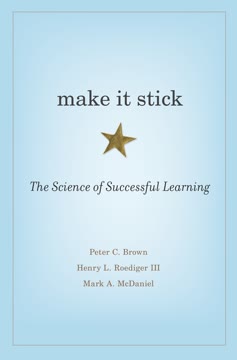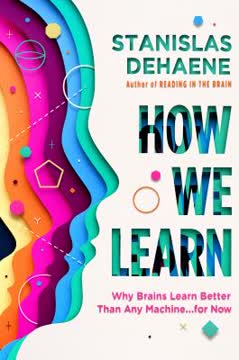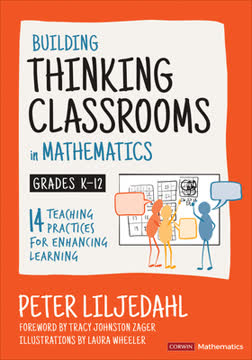Key Takeaways
1. Retrieval Practice: The Foundation of Powerful Learning
When we think about learning, we typically focus on getting information into students' heads. What if, instead, we focus on getting information out of students' heads?
Retrieval practice is the act of bringing information to mind, which significantly improves long-term retention and understanding. This contrasts with traditional methods like re-reading or passive listening, which often lead to short-term retention.
Key benefits of retrieval practice:
- Boosts learning by a letter grade or more
- Enhances higher-order thinking and transfer of knowledge
- Improves students' metacognition and awareness of their own learning
- Increases engagement and preparation for class
Implement retrieval practice through:
- Brain Dumps: Ask students to write everything they remember about a topic
- Two Things: Have students recall two key points from a previous lesson
- Mini-Quizzes: Use low-stakes, frequent quizzes to reinforce learning
- Retrieve-Taking: Encourage note-taking after, not during, lectures or readings
2. Spacing and Interleaving: Energize Learning Through Strategic Timing
Spacing is how we spread out content over time, whereas interleaving is how we mix things up.
Spacing involves spreading out learning over time, rather than cramming. Interleaving is the practice of mixing related but distinct concepts during study sessions.
Benefits of spacing and interleaving:
- Improves long-term retention
- Enhances discrimination between similar concepts
- Boosts learning of information in the middle of a unit
Implementation strategies:
- Revisit concepts days or weeks after initial learning
- Mix up practice problems from different units or chapters
- Use the "Fishbowl" technique: Draw topics randomly for review
- Implement "Big Basket Quizzes" that cover various topics from throughout the semester
Research shows that spacing and interleaving can improve test scores by nearly two letter grades compared to blocked or massed practice.
3. Feedback-Driven Metacognition: Engage Students in Self-Reflection
Without feedback, students' metacognition can remain overconfident and out of sync with their actual learning.
Feedback-driven metacognition involves students reflecting on their own learning process and receiving timely feedback to improve their understanding and retention.
Key components:
- Judgments of learning (JOLs): Students predict future recall
- Confidence ratings: Students assess their current understanding
- Immediate and delayed feedback: Provide both types for optimal learning
Strategies to implement:
- Use "Retrieval Cards" with the Four Steps of Metacognition
- Implement "Metacognition Sheets" for students to reflect on their learning
- Encourage "Breathe and Retrieve" moments during assessments
- Facilitate "Metacognition Line-Up" activities for class-wide reflection
Research demonstrates that incorporating metacognitive strategies can improve exam performance by nearly a letter grade.
4. Desirable Difficulties: Embrace Challenges for Deeper Understanding
Desirable difficulties don't feel good, but they're a good feeling to have.
Desirable difficulties are intentional challenges in the learning process that lead to deeper understanding and better long-term retention.
Characteristics of desirable difficulties:
- Initially feel uncomfortable or challenging
- Require more effort during learning
- Result in stronger, more flexible knowledge
Examples of desirable difficulties:
- Retrieval practice instead of passive re-reading
- Spaced learning rather than cramming
- Interleaved practice instead of blocked practice
- Generation of answers before receiving explanations
Emphasize to students that struggle during learning is often a sign of effective strategies, not failure. This mindset shift can help reduce anxiety and increase persistence in the face of challenges.
5. Combine Power Tools for Maximum Impact
With Power Tools, there's no need to make it more complicated.
Combining retrieval practice, spacing, interleaving, and feedback-driven metacognition creates a powerful synergy that maximizes learning outcomes.
Benefits of combining Power Tools:
- Reinforces learning through multiple pathways
- Addresses different aspects of the learning process
- Creates a more comprehensive and effective learning experience
Strategies for combination:
- Use "Power Tickets" that incorporate all four tools
- Implement spaced retrieval practice with interleaved content
- Provide feedback on retrieval attempts to boost metacognition
- Create cumulative review sessions that utilize all Power Tools
Research shows that combining Power Tools can boost exam performance by nearly a letter grade compared to using individual strategies alone.
6. Foster a Supportive Environment to Reduce Anxiety
Use Power Tools to increase learning and decrease anxiety in your classroom.
Creating a supportive learning environment is crucial for reducing student anxiety and maximizing the effectiveness of Power Tools.
Key elements of a supportive environment:
- Low-stakes or no-stakes retrieval opportunities
- Normalize making mistakes as part of the learning process
- Encourage risk-taking and effort over perfection
- Provide frequent, non-judgmental feedback
Strategies to implement:
- Use "Retrieval Warm-Ups" with no right or wrong answers
- Implement the "Noun-Name Tag" activity to build community
- Display supportive messages in the classroom (e.g., "It's okay to make mistakes. That's the way we learn.")
- Spread grades across multiple low-stakes retrieval opportunities
Research shows that 94% of students reported decreased or unchanged test anxiety after frequent retrieval practice.
7. Empower Students to Harness Power Tools Independently
When students experience the success of learning, students are motivated to take ownership and accountability for their own knowledge.
Teaching students to use Power Tools independently is crucial for long-term success and lifelong learning.
Steps to empower students:
- Spark conversations about learning processes
- Model Power Tools in the classroom
- Explain why Power Tools work
- Guide students in using Power Tools inside the classroom
- Teach strategies for using Power Tools outside the classroom
- Help students plan, implement, and reflect on their use of Power Tools
Strategies for independent use:
- Teach effective flashcard techniques (Retrieve, Reorder, Repeat)
- Encourage Retrieve-Taking instead of passive note-taking
- Guide students in creating their own retrieval practice questions
- Facilitate "Flash Forward" activities to reinforce long-term goals
By empowering students to use Power Tools independently, we equip them with lifelong learning strategies that extend beyond the classroom.
8. Spark Conversations with Parents About Learning Science
Parents want to know how their children learn. Parents want to know how to best help their children.
Engaging parents in the science of learning can create a powerful support system for students and reinforce the use of Power Tools outside the classroom.
Key points for parent communication:
- Explain the basic principles of how learning works
- Share specific, evidence-based strategies they can use at home
- Provide Research Snapshots to illustrate the effectiveness of Power Tools
Strategies for parent engagement:
- Host parent seminars on the science of learning
- Share "Tell Me Three" and "Powerful Flashcards" techniques
- Use the "Pain, Promise, Proof" approach in parent communications
- Provide resources and links for further learning about Power Tools
Research shows that 80% of parents are likely or very likely to learn about evidence-based learning strategies if made available to them.
9. Transform Professional Development with Power Tools
By understanding the science of learning, you not only hold the ball; you learn how to dribble it well, too.
Applying Power Tools to professional development can significantly enhance teacher learning and implementation of evidence-based strategies.
Key principles for powerful professional development:
- Move from "sit-and-get" to active retrieval
- Implement spacing and interleaving in PD schedules
- Incorporate feedback and metacognition for teacher reflection
Strategies for implementation:
- Use Retrieval Warm-Ups at the start of PD sessions
- Create spaced follow-ups after initial training
- Implement book clubs with interleaved discussion topics
- Encourage teacher-led workshops on Power Tools
- Develop accountability systems for ongoing implementation
By transforming professional development with Power Tools, educators can experience the benefits firsthand and become more effective advocates for evidence-based learning strategies in their classrooms.
Last updated:
FAQ
What's Powerful Teaching: Unleash the Science of Learning about?
- Focus on Learning Science: The book delves into the science of learning, emphasizing how cognitive science can be applied in educational settings to enhance student learning.
- Four Power Tools: It introduces four key strategies—retrieval practice, spaced practice, interleaving, and feedback-driven metacognition—grounded in cognitive science research.
- Practical Application: The authors provide actionable strategies for teachers to implement these tools in classrooms, making the science of learning accessible and applicable.
Why should I read Powerful Teaching: Unleash the Science of Learning?
- Bridge Between Research and Practice: The book serves as a manual for educators to apply cognitive science research in teaching, connecting theoretical concepts with real-world applications.
- Improves Student Outcomes: Implementing the strategies can significantly enhance student learning and retention, leading to better academic performance.
- Empowerment for Educators: It empowers teachers to move from anecdotal practices to research-backed strategies, fostering deeper learning.
What are the key takeaways of Powerful Teaching: Unleash the Science of Learning?
- Retrieval Practice is Essential: Actively recalling information strengthens memory and understanding, proving more effective than traditional study methods.
- Spacing and Interleaving: Spacing out learning and mixing topics enhance retention and understanding, combating the forgetting curve.
- Feedback-Driven Metacognition: Providing feedback helps students understand their knowledge gaps, crucial for effective learning.
What is retrieval practice as defined in Powerful Teaching: Unleash the Science of Learning?
- Definition of Retrieval Practice: It involves actively recalling information, which strengthens memory and learning.
- Benefits of Retrieval Practice: Research shows it significantly boosts long-term retention and understanding, helping identify knowledge gaps.
- Implementation in Classrooms: Teachers can use quizzes, Brain Dumps, and Think-Pair-Share activities to incorporate retrieval practice.
How does spacing improve learning according to Powerful Teaching: Unleash the Science of Learning?
- Definition of Spacing: Spacing involves spreading learning over time rather than cramming, allowing for better retention.
- Research Evidence: Studies show spaced practice leads to better long-term retention compared to cramming.
- Practical Application: Teachers can revisit topics periodically and incorporate retrieval opportunities at intervals.
What is interleaving, and how does it benefit learning in Powerful Teaching: Unleash the Science of Learning?
- Definition of Interleaving: It involves mixing different topics or types of problems during study sessions.
- Research Findings: Interleaving can double student learning compared to blocked practice, enhancing problem-solving skills.
- Classroom Strategies: Teachers can alternate between subjects or question types in assessments and practice sessions.
How does feedback-driven metacognition work in Powerful Teaching: Unleash the Science of Learning?
- Definition of Metacognition: It refers to students' awareness and understanding of their learning processes.
- Importance of Feedback: Feedback helps students recognize strengths and weaknesses, correcting misconceptions and reinforcing understanding.
- Strategies for Implementation: Teachers can encourage self-reflection using tools like Retrieval Cards and Metacognition Sheets.
What are some effective strategies for implementing retrieval practice in the classroom from Powerful Teaching: Unleash the Science of Learning?
- Brain Dumps: Students write down everything they remember about a topic, boosting learning and organizing knowledge.
- Two Things: Students note two things learned during a lesson, reinforcing retrieval and encouraging discussion.
- Mini-Quizzes: Regular low-stakes quizzes assess knowledge and provide immediate feedback, enhancing retention.
How can I create a supportive environment for using Power Tools in my classroom according to Powerful Teaching: Unleash the Science of Learning?
- Normalize Mistakes: Encourage viewing mistakes as learning opportunities, fostering a growth-oriented classroom culture.
- Use Positive Reinforcement: Celebrate efforts in retrieving information, boosting confidence and motivation.
- Foster Collaboration: Implement group activities promoting discussion and peer feedback, reinforcing understanding collectively.
What are some common misconceptions about learning addressed in Powerful Teaching: Unleash the Science of Learning?
- Learning Styles Myth: The book debunks the idea that students learn better in their preferred style, advocating varied methods.
- Brain-Based Learning: It critiques "brain-based learning" as vague, promoting specific, research-backed strategies instead.
- Cramming Effectiveness: Cramming may lead to short-term success but harms long-term retention, encouraging effective study habits.
What are the best quotes from Powerful Teaching: Unleash the Science of Learning and what do they mean?
- “When it comes to learning, easier isn't better.”: Challenges like retrieval practice and spacing lead to deeper learning and better retention.
- “Power Tools are desirable difficulties.”: Challenges in learning are beneficial, enhancing understanding and memory.
- “We must stop driving instruction with anecdotes and fads.”: Educators should rely on research-based strategies for effective teaching.
What is the concept of "desirable difficulties" in Powerful Teaching: Unleash the Science of Learning?
- Definition of Desirable Difficulties: These are challenges that enhance learning by requiring effort and engagement.
- Benefits of Challenges: They push students to engage more deeply with material, improving retention and understanding.
- Application in Teaching: Teachers can incorporate retrieval practice, spacing, and interleaving to create beneficial challenges.
Review Summary
Powerful Teaching receives high praise from educators for its practical, research-based strategies to enhance student learning. Readers appreciate the balance of cognitive science and classroom applications, finding it accessible and immediately implementable. The book's focus on retrieval practice, spaced practice, interleaving, and metacognition resonates with teachers across grade levels. Many reviewers note its similarity to other books on learning science but value its unique classroom focus. Some readers suggest the audiobook format is less effective due to the interactive nature of the content.
Similar Books










Download PDF
Download EPUB
.epub digital book format is ideal for reading ebooks on phones, tablets, and e-readers.




